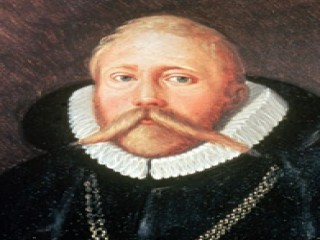
Tycho Brahe biography
Date of birth : 1546-12-14
Date of death : 1601-10-24
Birthplace : Knutstorp Castle, Scania
Nationality : Danish
Category : Arhitecture and Engineering
Last modified : 2011-06-02
Credited as : Astronomer, and alchemist, De nova stella
8 votes so far
Tycho Brahe isn't as famous as Galileo or Copernicus, but in some circles he's considered the father of modern astronomy. He spent much of his life compiling the world's first truly accurate and complete set of astronomical tables -- all before the invention of the telescope. Brahe's assistant, Johannes Kepler, later used the tables to deduce the laws of planetary motion. In 1628 Kepler published the Rudolphine Tables, a list of remarkably accurate logarithmic astronomical tables based on Brahe's observations and Kepler's subsequent analysis.
In his De nova stella (On the new star) of 1573, he refuted the theory of the celestial spheres by showing the celestial heavens were not in an immutable or unchanging state of perfection as previously assumed by Aristotle and Ptolemy. His precise measurements indicated that "new stars" (novae or also now known as supernovae), in particular that of 1572, lacked the parallax expected in sub-lunar phenomena, and were therefore not "atmospheric" tail-less comets as previously believed, but occurred above the atmosphere and moon. Using similar measurements he showed that comets were also not atmospheric phenomena, as previously thought, and must pass through the supposed "immutable" celestial spheres.
Tycho Brahe was granted an estate on the island of Hven and the funding to build the Uraniborg, an early research institute, where he built large astronomical instruments and took many careful measurements, and later Stjerneborg, underground, when he discovered that his instruments in the former were not sufficiently steady. Something of an autocrat on the island he nevertheless founded manufactories such as paper-making to provide material for printing his results. Something akin to a research institute was founded which John Napier attended. After disagreements with the new Danish king in 1597, he was invited by the Bohemian king and Holy Roman emperor Rudolph II to Prague, where he became the official imperial astronomer. He built the new observatory at Benátky nad Jizerou. Here, from 1600 until his death in 1601, he was assisted by Johannes Kepler. Kepler later used Tycho's astronomical results to develop his own theories of astronomy.
As an astronomer, Tycho worked to combine what he saw as the geometrical benefits of the Copernican system with the philosophical benefits of the Ptolemaic system into his own model of the universe, the Tychonic system. Furthermore, he was the last of the major naked eye astronomers, working without telescopes for his observations.

















